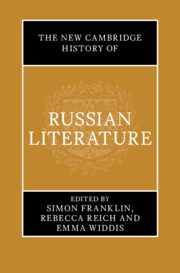Book contents
- The New Cambridge History of Russian Literature
- The New Cambridge History of Russian Literature
- Copyright page
- Contents
- Figures
- Contributors
- Acknowledgements
- On Transliteration, Names, and Dates
- Introduction
- History 1 Movements
- History 2 Mechanisms
- History 3 Forms
- History 4 Heroes
- 4.1 The Saint
- 4.2 The Ruler
- 4.3 The Lowly Civil Servant
- 4.4 The Peasant
- 4.5 The Intelligent
- 4.6 The Russian Woman
- 4.7 The New Person
- 4.8 The Non-Russian
- 4.9 The Madman
- 4.10 The Émigré
- Index
- References
4.1 - The Saint
from History 4 - Heroes
Published online by Cambridge University Press: 31 December 2024
- The New Cambridge History of Russian Literature
- The New Cambridge History of Russian Literature
- Copyright page
- Contents
- Figures
- Contributors
- Acknowledgements
- On Transliteration, Names, and Dates
- Introduction
- History 1 Movements
- History 2 Mechanisms
- History 3 Forms
- History 4 Heroes
- 4.1 The Saint
- 4.2 The Ruler
- 4.3 The Lowly Civil Servant
- 4.4 The Peasant
- 4.5 The Intelligent
- 4.6 The Russian Woman
- 4.7 The New Person
- 4.8 The Non-Russian
- 4.9 The Madman
- 4.10 The Émigré
- Index
- References
Summary
Translated Byzantine lives of saints occupied considerable space in the hagiographic corpus of Rus and medieval Russia. But original (non-translated) vitae differ significantly from their Greek models in several respects: the very causes of their subjects’ sanctity (the Rus corpus emphasises saintly princes and founders of monasteries); their extremes of self-mortification (as in the case of Varlaam of Keret); and the extravagance of their feats (such as those of Andrew of Crete, or Petr and Fevroniia). Compared to Byzantine hagiography, the Lives of holy fools are overrepresented in the repertoire of medieval Rus, while female saints are underrepresented in it. In the modern era, Russian literature has drawn heavily on the medieval vitae. This tradition became pronounced in the mid-nineteenth century, but communist writers of the twentieth century also fashioned their heroes in the hagiographic mould.
- Type
- Chapter
- Information
- The New Cambridge History of Russian Literature , pp. 683 - 698Publisher: Cambridge University PressPrint publication year: 2024

